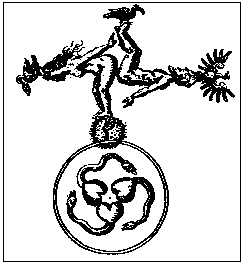The alchemical-astrological notions of the Sun and the Moon in this part are very well explaining basic ideas to make more sense of following moon cycles and the annual cycles tying up the quadrant ideas of the elements/seasons/image of self from the mandala chapter. These are almost as vibrantly striking to me as the notion presented by Zosimos of the divine man being lured in to the elemental suit. A mental image that just makes so much sense to me.
More over the masculine feminine sides of Mercury was very interesting and something I just happened to be thinking with focus earlier the day of reading this subchapter. Sapientia as divine female sounded alot like Venus. And yet Jung seems point the masculine and feminine sides of Mercury to be here that of Sun and the Moon, which also makes sense. This inspires me to further study the seven spirits within each other, how do they align to make a whole that makes sense to me.
I was kind of sensing the red thread somewhere in those gender polarities of Mercury: the dynamism between the water/sea and desert/fire and their respected alchemical phases connecting to the androgynous nature of the lapis and Christ. But it seemed to be only implied as the author didn’t come to completely meet the red thread in the end, yet it made following it all the more fascinating ecspecially so when I’ve been thinking about the same themes on my own lately. The connection of the mother and the son we discussed some time ago on another topic in the Finnish side, but there’s some other feminine aspect I’m really interested researching. I can’t quite point it so I might have to leave it to be written more about later.
Uh, there's so much things here that has been very central to my study lately yet it's hard to put them in to a clear picture of the whole. These winds from the cardinal directions first of all connect to the rota of the great wheel, which seems to be one with the idea in Book of Dzyan: the Fohat striking (the lightning of Eros) in the fiery whirwinds. Then in the footnote regarding Phanes, you kindly noted on the Red Book reading circle:
The two Mothers and the two Fathers guarding the jug made of stone remind me of the image pointed again in this subchapter where there's a man and a woman forming a cross, but as they are bend in 90 degree angles one of each are enough to image the masculine-feminine polarities of the two poles of the cross. Another very interesting and clarifying notion on this same theme can be seen in a painting by D.G. Rossetti, named Lady Lilith. I've been writing an article on this, but might as well contribute with the thoughts here as the themes are coming together here. There's two candles behind Lilith right next to a mirror, making all and all two pairs. The mirror image opens up to a lush world of spring very much in the sense that is described in the Phanes footnote (those parts I left out from the quote above), while it would be expected that the mirror image would mirror the confined, separate and dark surroundings Lilith occupies. The candles are mirrored but they are extinguished, there's no fire that would pass through the fire from the world beyond to this demonic existence of Lilith. So the beauty of Lilith is something similar to Narcissus' beauty, confined in a nihilistic existence not reaching the greater whole through the mirror behind her. The two Mothers and the two Fathers - the four Guardians ask for work to be done to allow it. And the work, according to Jung seems to be that of dividing the one element in to four to make them equal and balanced, and to know them to be able to work with them, thus granting oneself access through the Guards and become them, employ or serve them.Red Book p. 359 wrote:The jug made of stone, the vessel of completion, Water flowed in, wine flowed in, milk flowed in, blood flowed in. / The fours Winds Precipitated into the precious vessel. / The Gods of the four Heavenly Realms hold its curvature, the two Mothers and the two Fathers guard it, the fire of the North Burns above its mouth, the serpent of the South encircles its bottom, the spirit of the East holds one of its sides and the spirit of the West the other./ Forever denied it exists forever. Recurring in all forms, forever the same, this one precious vessel, surrounded by the Circle of animals, denying itself, and arising in a new Splendor through its self-denial.

I wonder if these four winds, four liquids - the quadral elements have their numeral root in the four Kumaras, are Kumaras the Guardians and the mouths who blow the four winds? This is something of a confusion I've been stuck in lately. Some times when doing the Om Mani Padme Hum mantra, I've intuitively thought in the 'Mani' part these guardians in the sun-cross/the great wheel to be Kumaras.
